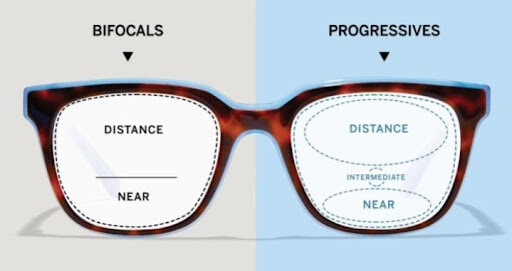WHAT ARE PROGRESSIVE LENSES?
Progressive lenses also called multifocal lenses are a type of corrective lens used in spectacles to correct presbyopia, myopia, and other disorders of accommodation in the human eye. To put it plainly, these lenses allow you to see clearly at multiple distances without a bifocal line.
The need for progressive lenses increases with age as far and near vision gets disturbed. For this, many people wear glasses for distance vision and reading glasses for up-close objects. Progressive lens glasses solve this issue as their gradient starts at the wearer’s distance prescription at the top of the lens and reaches a maximum addition power or the full reading addition at the bottom of the lens.
Adapting to a progressive lens can be a bit of a challenge for some people as it takes time to adjust due to the visual distortions it causes for some people (Kim 2021).
Bifocal and trifocal lenses have a visible line so it is easy for the wearer to determine where to look for clear vision. As progressive lenses have no visible line, adapting to them can take one to two weeks and this can be a bit of a learning curve.
You need to shift to progressive lenses as:
- You will need only one pair of glasses
- There is no distracting bifocal line
- It gives a more modern vibe to your personality.

Some of the problems experienced by people with the use of a progressive lens in the beginning are:
- Headaches
- Depth perception issues. which usually depicts that the wearer is sometimes unable to not determine how far away some objects are from him
- Dizziness and nausea
- Swim and sway effect
- Discomfort when walking on the stairs

- The feeling of having a narrow field of vision due to peripheral vision distortion

- Difficulty focusing between different intermediate and near distances.
TIPS FOR ADAPTING TO PROGRESSIVE LENS
This list might seem to be a long one and a real deal-breaker but with the help of some tips, you can quickly adapt to your new set of progressive lenses.
- Wear them as your primary pair and try to wear them as long as possible. Don’t try to shift between your old pair as wearing them less will take more time to adjust
- You’ll need to find and use new areas in your lenses instead of using whatever space is more convenient. There are 3 main areas: far, intermediate and near. Learn the zones in your lenses and use them properly.
- Make sure you have a comfortable frame that is adjusted for your face
- Make sure the optician fits the lens in the right way with the right equipment
- In the optometry exam, tell your optician about your main activities (e.g hobbies, line of work, with family, etc.). After knowing about these details, they can suggest the right lens design specially personalized for your lifestyle.
- The new progressive lenses can now be customized to your parameters, like:
– The inclination angle of the lenses on your face,
– Their tilt angle (curved frame shape)
– How far is the distance from your lens to the cornea of your eye?
– Other parameters.
Having your parameters considered in the geometric design of the lenses will help you enjoy the most adequate progressive lenses and ensure faster adaptation.

Recent Posts
- Castor Oil For Better Hair Growth: Is It Myth Or Fact?
- Exploring the Differences Between Sermorelin, Ipamorelin, Ibutamoren, GHRP2, and GHRP6: Understanding Their Role in Human Growth Hormone Regulation
- Unraveling the Mystery: Understanding the Causes and Prognosis of Ventricular Tachycardia Without Apparent Heart Disease
- Understanding Grandparents’ Rights in Oklahoma: Navigating Visitation and Legal Protections
- 10 Reasons to Consider Hypnotherapy for Your Health

